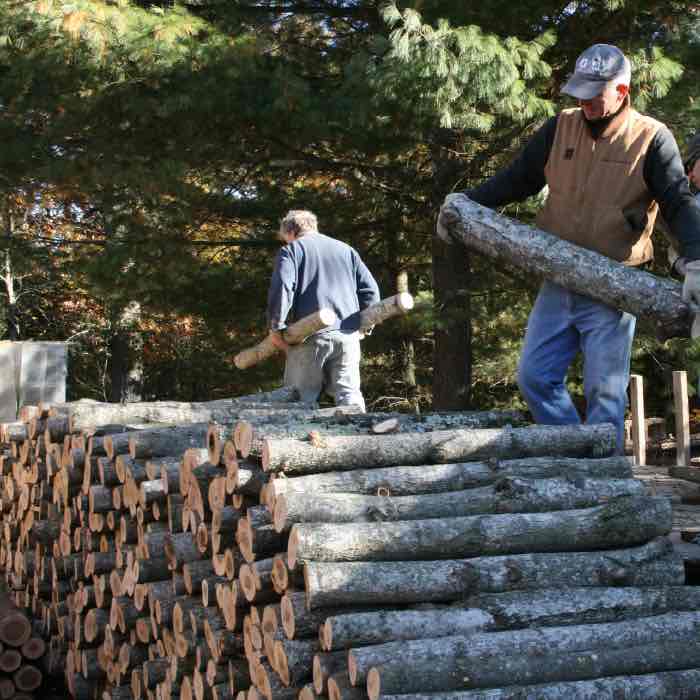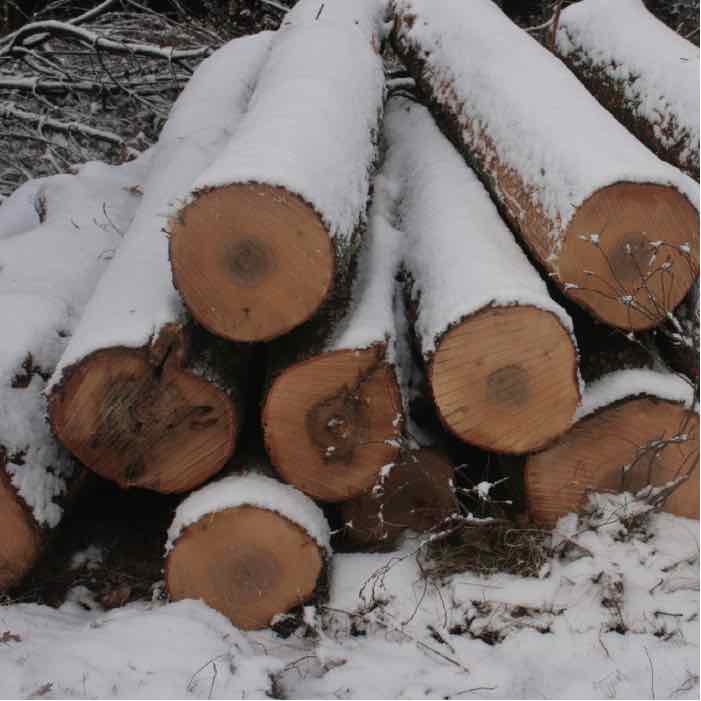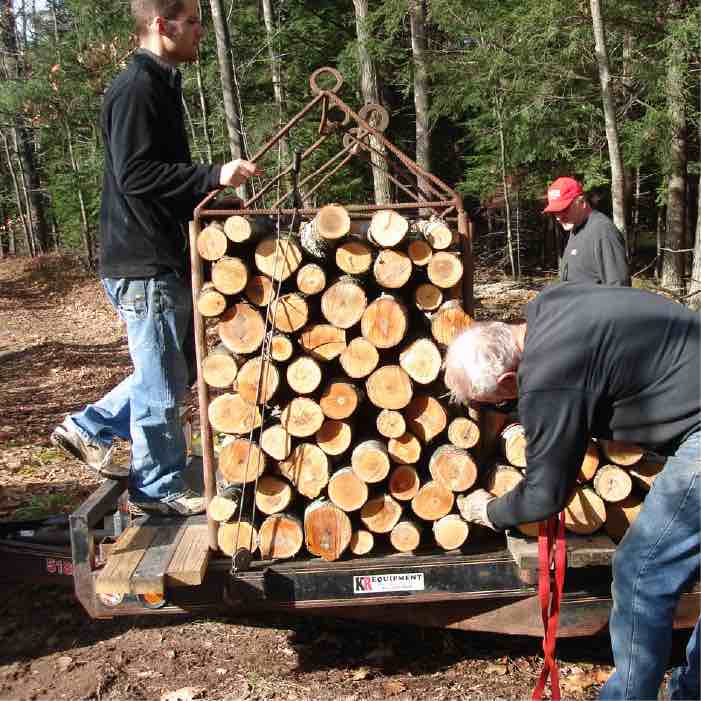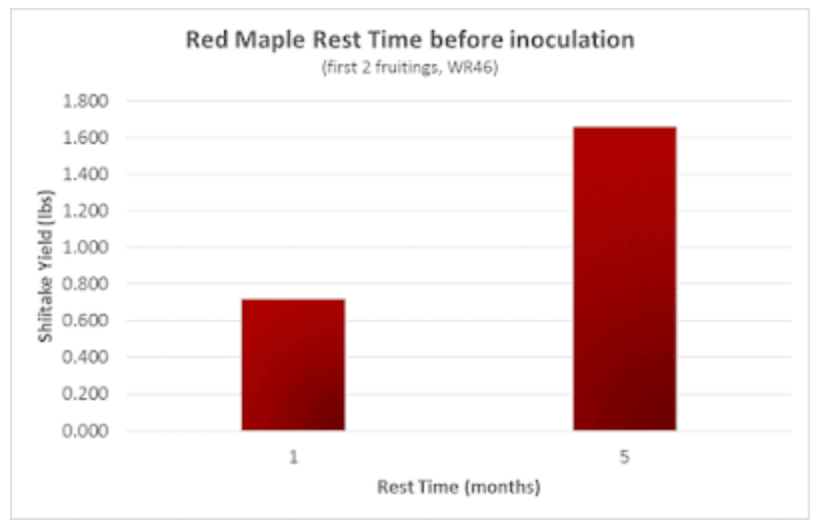If you are planning on inoculating logs this spring, the following tips can help answer some questions you may have. Plus, research results concerning cutting and aging wood for shiitake logs. It's never too early to be thinking about cutting wood for mushroom logs!



What Makes Ideal Mushroom Logs
Start with the best quality logs whenever possible. Most experienced growers know that the quality of the fresh cut log is crucial to spawn run success and mushroom yield, and it starts with the log as it is cut from the tree. We all know the importance of cutting healthy, living wood in its dormancy. If you are cutting softer hardwoods such as Silver or Red Maple, select stems that have thicker, rougher bark. Logs with thicker bark will have a longer, more productive life.
Curing Mushroom Logs Prior to Inoculation
Use best practices for storing the logs prior to inoculation. It turns out that certain wood species, due to their cell structure and bark characteristics, may prefer a longer seasoning time prior to inoculation (read next item below for more details). The longer "seasoning time" can positively influence overall mushroom yield. Wood should "season" at least 2 weeks before planting; longer for some wood species. Historically, the rule of the thumb has been "fresh is best," when it comes to deciding how long logs can sit after cutting before inoculation. Why? These very fresh logs are free of contamination because the living tree was warding off invasion of weed fungi. Fresh cut logs have abundant moisture, but must start to loose some of the free water before inoculation. Allowing logs too little time to season can result in a lag time in spawn run after inoculation. Spawn must wait for the log to start drying so the log can be hospitable to fungal growth. Trees have differing moisture contents by species, age and environment, but across the board it is moisture loss, the key factor in determining if wood is inoculation-ready, that suggests that the logs cure for AT LEAST 2 WEEKS prior to inoculation. This time allows for the free moisture in the log to be released but holds in the bound moisture, necessary for Shiitake growth.
The log with sprout suggests lack of cure time prior to inoculation and you'll notice a lag in spawn run (no white mycelium on log end). A 2 week cure period may not be long enough for some logs - especially in Red Maple (and probably most other maples). Over the years we've followed the 2 week resting rule across the board in our harvested logs, regardless of wood type, but noticed remarkable yield difference in Red Maple logs rested for 2 weeks compared to several months of rest. We decided to take a closer look, and to see if the same trend was also true for Sugar Maple, a related species.

Cure Red Maple a few months prior to inoculation, even if the bark is thinner than you would like. The longest rest time in both the Sugar Maple and Red Maple in our study resulted in the highest yielding shiitake logs. In 2016/2017 we harvested Sugar Maple logs which were divided into two groups, one inoculated 1 month after cutting, and the other 6 months after cutting. Similarly, Red Maple logs were divided into two groups and were inoculated either 1 month or 5 months after cutting. All logs were incubated together under the same conditions then force fruited the following year to collect Shiitake yield information. Logs with the longest rest time prior to inoculation in both the Sugar Maple and the Red Maple proved to be the highest yielding Shiitake logs. Based on the results of this study, longer rest times for Red and Sugar Maple logs can increase spawn run success and overall Shiitake mushroom yields. Keep in mind that this study was conducted in northern Wisconsin where temperatures are cold and logs are covered in snow during seasoning. Logs cut in the south will dry faster and season quicker, so the 5 month time will likely be too long for those areas.
Keep in mind:
Logs that are freshly cut from a healthy, living tree in its dormant state will always yield best results! Other logs may be used, but temper expectations as far as productivity of the logs.
How to Store Mushroom Logs Prior to Inoculation
Protect your logs if you wait to inoculate. There are caveats to longer rest times. Below is a list of risks and how to manage them:
1. Losing log moisture - Store your logs properly in the shade, out of the sun and the wind to reduce this risk. Especially with thin barked trees like Red Maple, take care to minimize moisture loss over a longer storage period.
2. Felling and leaving the tree whole and cutting it up just prior to inoculation is a good strategy for long months of curing, especially in snowy areas.
3. Stacking logs on a building's north side also helps. You may dead stack them and cover them loosely with a breathable cloth to allow penetration of rain and snow.
4. Before inoculating, check the ends of the logs for cracks. Small cracks are okay. If the cracks are wider than the width of a dime, then soak your logs in water for 12-24 hours prior to inoculation.
5. Logs awaiting inoculation should be dead stacked on limb wood rails to minimize soil contact (see photo above).
6. Avoiding Contamination: If logs are cut into lengths prior to curing, store them off the ground, elevated slightly by rails or a pallet to avoid soil contact. Avoid consistently wet bark by trapping logs as they rest if you have weeks of continuous rainy weather.
We wish you a spring season with mushroom-loaded Shiitake logs!